商标名称翻译中的文化因素及影响
- 格式:pdf
- 大小:150.43 KB
- 文档页数:1

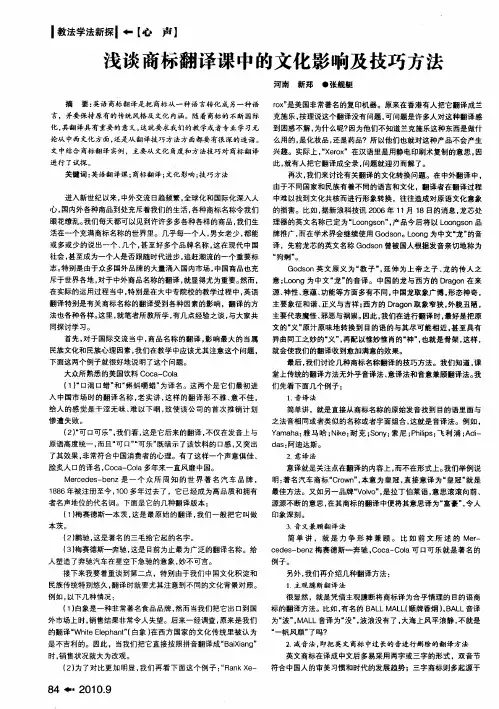
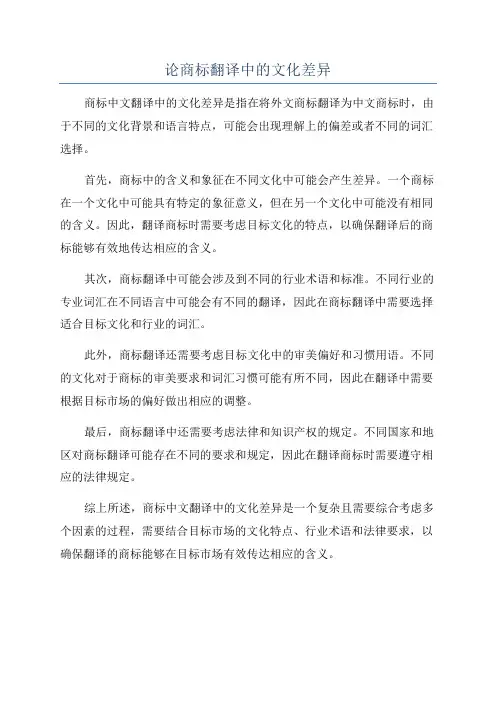
论商标翻译中的文化差异
商标中文翻译中的文化差异是指在将外文商标翻译为中文商标时,由于不同的文化背景和语言特点,可能会出现理解上的偏差或者不同的词汇选择。
首先,商标中的含义和象征在不同文化中可能会产生差异。
一个商标在一个文化中可能具有特定的象征意义,但在另一个文化中可能没有相同的含义。
因此,翻译商标时需要考虑目标文化的特点,以确保翻译后的商标能够有效地传达相应的含义。
其次,商标翻译中可能会涉及到不同的行业术语和标准。
不同行业的专业词汇在不同语言中可能会有不同的翻译,因此在商标翻译中需要选择适合目标文化和行业的词汇。
此外,商标翻译还需要考虑目标文化中的审美偏好和习惯用语。
不同的文化对于商标的审美要求和词汇习惯可能有所不同,因此在翻译中需要根据目标市场的偏好做出相应的调整。
最后,商标翻译中还需要考虑法律和知识产权的规定。
不同国家和地区对商标翻译可能存在不同的要求和规定,因此在翻译商标时需要遵守相应的法律规定。
综上所述,商标中文翻译中的文化差异是一个复杂且需要综合考虑多个因素的过程,需要结合目标市场的文化特点、行业术语和法律要求,以确保翻译的商标能够在目标市场有效传达相应的含义。

商标互译中的文化探微摘要:商标及商标词作为语言的组成部分,不可避免地受到各国、各民族文化的影响与制约。
从很多商标词中我们可透视它所包含的丰富的社会历史文化蕴涵. 故而本文从商标词的语言文化特征入手, 进而详细地从商标翻译中的用词、文化因素、方法这三方面的问题揭示商标语与文化的深刻关联,并针对这些关联,相应地提出一些在翻译中适当的方法手段,以使译文符合译语读者的文化习惯.关键词:商标词翻译规则方法文化因素Abstract: Trademarks and trademark dictions, as a part of language, are unavoidably influenced and restricted by the culture of various countries and nationalities. We can see through trademarks to get he abundant implications of social history and culture. By proceeding with the language and culture characters of the trademark words and illustrating diction, cultural elements and methodsof trademarks translation in details, this paper tries to reveal the profound relationship between trademarks and culture, and to put forward some proper translation so as to make the target language cater for the culture of target language readers.Keyword: trademark dictions translation rules methods cultural elements一引言语言作为文艺工作的组成部分,既是文化的表现形式,又是一种社会文化现象。
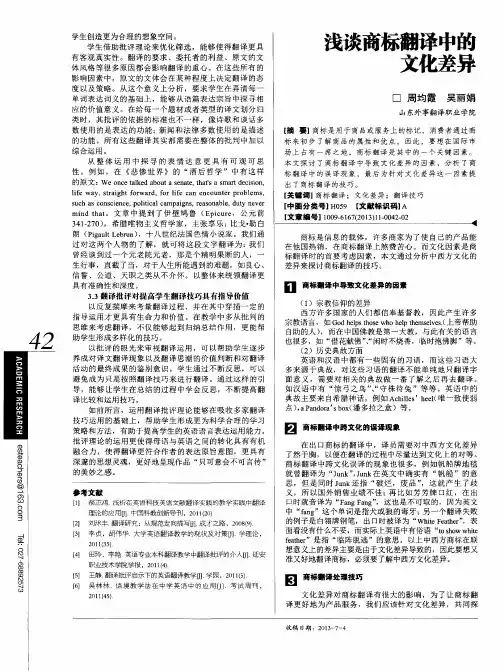
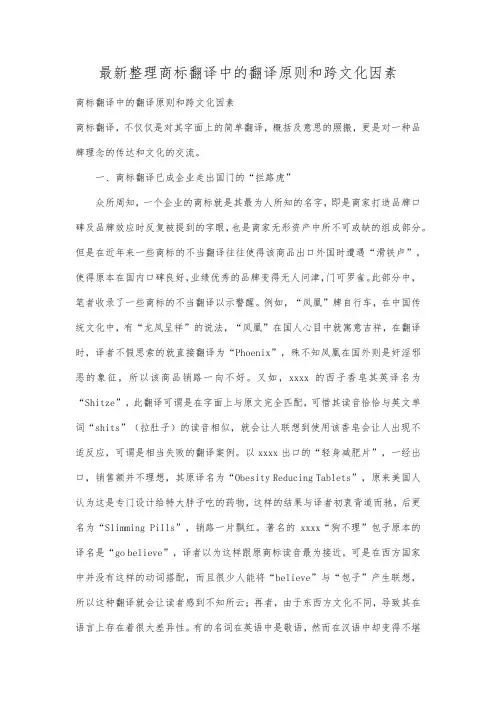
最新整理商标翻译中的翻译原则和跨文化因素商标翻译中的翻译原则和跨文化因素商标翻译,不仅仅是对其字面上的简单翻译,概括及意思的照搬,更是对一种品牌理念的传达和文化的交流。
一、商标翻译已成企业走出国门的“拦路虎”众所周知,一个企业的商标就是其最为人所知的名字,即是商家打造品牌口碑及品牌效应时反复被提到的字眼,也是商家无形资产中所不可或缺的组成部分。
但是在近年来一些商标的不当翻译往往使得该商品出口外国时遭遇“滑铁卢”,使得原本在国内口碑良好,业绩优秀的品牌变得无人问津,门可罗雀。
此部分中,笔者收录了一些商标的不当翻译以示警醒。
例如,“凤凰”牌自行车,在中国传统文化中,有“龙凤呈祥”的说法,“凤凰”在国人心目中就寓意吉祥,在翻译时,译者不假思索的就直接翻译为“Phoenix”,殊不知凤凰在国外则是奸淫邪恶的象征,所以该商品销路一向不好。
又如,xxxx的西子香皂其英译名为“Shitze”,此翻译可谓是在字面上与原文完全匹配,可惜其读音恰恰与英文单词“shits”(拉肚子)的读音相似,就会让人联想到使用该香皂会让人出现不适反应,可谓是相当失败的翻译案例。
以xxxx出口的“轻身减肥片”,一经出口,销售额并不理想,其原译名为“Obesity Reducing Tablets”,原来美国人认为这是专门设计给特大胖子吃的药物,这样的结果与译者初衷背道而驰,后更名为“Slimming Pills”,销路一片飘红。
著名的xxxx“狗不理”包子原本的译名是“go believe”,译者以为这样跟原商标读音最为接近,可是在西方国家中并没有这样的动词搭配,而且很少人能将“believe”与“包子”产生联想,所以这种翻译就会让读者感到不知所云;再者,由于东西方文化不同,导致其在语言上存在着很大差异性。
有的名词在英语中是敬语,然而在汉语中却变得不堪入耳。
例如:三色堇服饰的英文译名就是“Pansy”,可是其在英文中还有“同性恋”的意思,消费者害怕买了这样的衣服就会被别人带上有色眼镜看待,自然就退避三舍,在商标翻译中这种现象也是层出不穷。
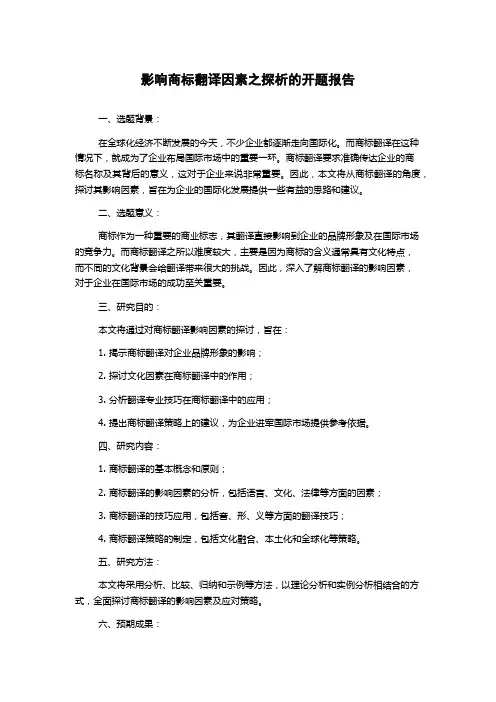
影响商标翻译因素之探析的开题报告一、选题背景:在全球化经济不断发展的今天,不少企业都逐渐走向国际化。
而商标翻译在这种情况下,就成为了企业布局国际市场中的重要一环。
商标翻译要求准确传达企业的商标名称及其背后的意义,这对于企业来说非常重要。
因此,本文将从商标翻译的角度,探讨其影响因素,旨在为企业的国际化发展提供一些有益的思路和建议。
二、选题意义:商标作为一种重要的商业标志,其翻译直接影响到企业的品牌形象及在国际市场的竞争力。
而商标翻译之所以难度较大,主要是因为商标的含义通常具有文化特点,而不同的文化背景会给翻译带来很大的挑战。
因此,深入了解商标翻译的影响因素,对于企业在国际市场的成功至关重要。
三、研究目的:本文将通过对商标翻译影响因素的探讨,旨在:1. 揭示商标翻译对企业品牌形象的影响;2. 探讨文化因素在商标翻译中的作用;3. 分析翻译专业技巧在商标翻译中的应用;4. 提出商标翻译策略上的建议,为企业进军国际市场提供参考依据。
四、研究内容:1. 商标翻译的基本概念和原则;2. 商标翻译的影响因素的分析,包括语言、文化、法律等方面的因素;3. 商标翻译的技巧应用,包括音、形、义等方面的翻译技巧;4. 商标翻译策略的制定,包括文化融合、本土化和全球化等策略。
五、研究方法:本文将采用分析、比较、归纳和示例等方法,以理论分析和实例分析相结合的方式,全面探讨商标翻译的影响因素及应对策略。
六、预期成果:本文旨在提出商标翻译的影响因素及应对策略,为企业在国际市场拓展中提供有益的参考依据。
同时,通过本文的研究,有望在商标翻译领域探索出一条适合中外企业在国际化过程中的商标翻译路径。
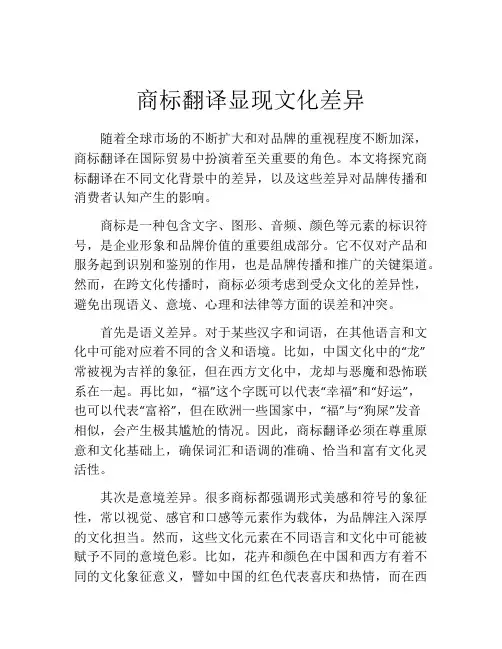
商标翻译显现文化差异随着全球市场的不断扩大和对品牌的重视程度不断加深,商标翻译在国际贸易中扮演着至关重要的角色。
本文将探究商标翻译在不同文化背景中的差异,以及这些差异对品牌传播和消费者认知产生的影响。
商标是一种包含文字、图形、音频、颜色等元素的标识符号,是企业形象和品牌价值的重要组成部分。
它不仅对产品和服务起到识别和鉴别的作用,也是品牌传播和推广的关键渠道。
然而,在跨文化传播时,商标必须考虑到受众文化的差异性,避免出现语义、意境、心理和法律等方面的误差和冲突。
首先是语义差异。
对于某些汉字和词语,在其他语言和文化中可能对应着不同的含义和语境。
比如,中国文化中的“龙”常被视为吉祥的象征,但在西方文化中,龙却与恶魔和恐怖联系在一起。
再比如,“福”这个字既可以代表“幸福”和“好运”,也可以代表“富裕”,但在欧洲一些国家中,“福”与“狗屎”发音相似,会产生极其尴尬的情况。
因此,商标翻译必须在尊重原意和文化基础上,确保词汇和语调的准确、恰当和富有文化灵活性。
其次是意境差异。
很多商标都强调形式美感和符号的象征性,常以视觉、感官和口感等元素作为载体,为品牌注入深厚的文化担当。
然而,这些文化元素在不同语言和文化中可能被赋予不同的意境色彩。
比如,花卉和颜色在中国和西方有着不同的文化象征意义,譬如中国的红色代表喜庆和热情,而在西方则有时会被认为代表危险和禁忌。
再比如,红牛公司的商标中,一只跳跃的“红牛”象征着活力和竞争力,但在沙特阿拉伯等穆斯林国家中,牛被视为一种不洁动物,会给当地消费者带来忌讳的心理障碍。
因此,商标翻译需根据受众文化的情境和特点,理解意境的内涵和外延,准确、简明地传达文化概念和情感感受。
再次是心理差异。
商标作为品牌形象的核心元素,在消费者的认知和情感方面扮演着重要作用。
但是,尽管同样的商标可能在不同文化和社会背景中都产生良好的效果,但消费者对商标的看法和印象仍然受到文化心理和认知差异的影响。
比如,可口可乐公司在亚洲市场上推出的“开心果”商标,将目光向日本,却被该国消费者视为“开心橙”商标的变体,而不是“开心GO!COKE”基本概念的变形。
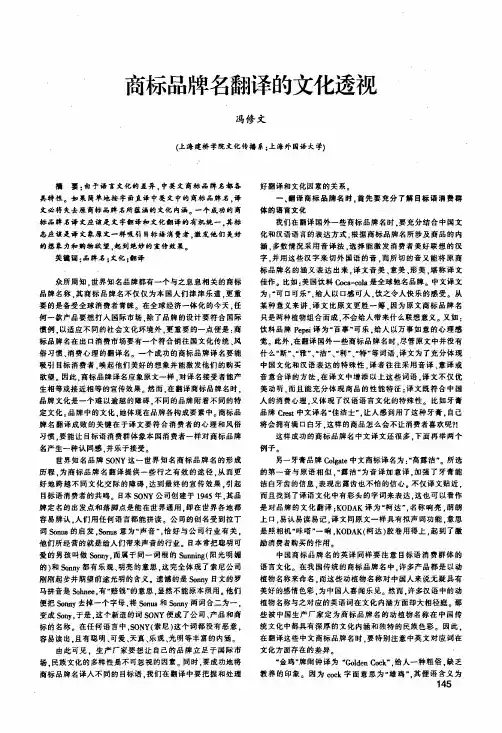
商标品牌名翻译的文化透视冯修文(上海建桥学院文化传播系;上海外国语大学)摘要:由于语言文化的差异,中英文商标品牌名都各具特性。
如果简单地按字面直译中英文中的商标品牌名.译文必将失去原商标品牌名所蕴涵的文化内涵。
一个成功的商标品牌名译文应该是文字翻译和文化翻译的有机统一.其标志应该是译文象原文一样吸引目标语消费者.激发他们美好的想象力和购物欲望.起到绝妙的宣传效果。
关键词:品牌名;文化;翻译众所周知.世界知名品牌都有一个与之息息相关的商标品牌名称.其商标品牌名不仅仅为本国人们津津乐道,更重要的是备受全球消费者青睐。
在全球经济一体化的今天,任何一款产品要想打入国际市场.除了品牌的设计要符合国际惯例.以适应不同的社会文化环境外.更重要的一点便是:商标品牌名在出口消费市场要有一个符合销往国文化传统、风俗习惯、消费心理的翻译名。
一个成功的商标品牌译名要能吸引目标消费者.唤起他们美好的想象并能激发他们的购买欲望。
因此,商标品牌译名应象原文一样,对译名接受者能产生相等或接近相等的宣传效果。
然而,在翻译商标品牌名时,品牌文化是一个难以逾越的障碍.不同的品牌附着不同的特定文化。
品牌中的文化.她体现在品牌各构成要素中。
商标品牌名翻译成败的关键在于译文要符合消费者的心理和风俗习惯.要能让目标语消费群体象本国消费者一样对商标品牌名产生一种认同感.并乐于接受。
世界知名品牌SO N Y这一世界知名商标品牌名的形成历程。
为商标品牌名翻译提供一些行之有效的途径.从而更好地跨越不同文化交际的障碍,达到最终的宣传效果.引起目标语消费者的共鸣。
日本SO N Y公司创建于1945年,其品牌定名的出发点和落脚点是能在世界通用.即在世界各地都容易辨认。
人们用任何语言都能拼读。
公司的创名受到拉丁词S0nm的启发,s onus意为。
声音”,恰好与公司行业有关。
他们所经营的就是给人们带来声音的行业。
日本常把聪明可爱的男孩叫做鼬加Y,而属于同一词根的Su肌洫g(阳光明媚的)和Sonnv都有乐观、明亮的意思.这完全体现了索尼公司刚刚起步并期望前途光明的含义。
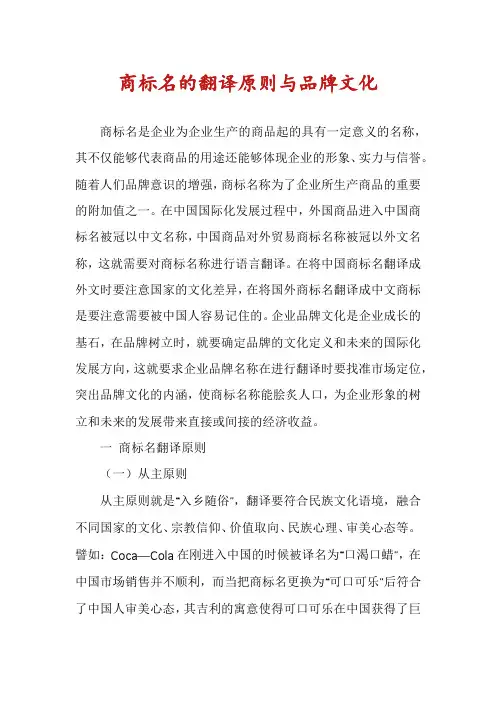
商标名的翻译原则与品牌文化商标名是企业为企业生产的商品起的具有一定意义的名称,其不仅能够代表商品的用途还能够体现企业的形象、实力与信誉。
随着人们品牌意识的增强,商标名称为了企业所生产商品的重要的附加值之一。
在中国国际化发展过程中,外国商品进入中国商标名被冠以中文名称,中国商品对外贸易商标名称被冠以外文名称,这就需要对商标名称进行语言翻译。
在将中国商标名翻译成外文时要注意国家的文化差异,在将国外商标名翻译成中文商标是要注意需要被中国人容易记住的。
企业品牌文化是企业成长的基石,在品牌树立时,就要确定品牌的文化定义和未来的国际化发展方向,这就要求企业品牌名称在进行翻译时要找准市场定位,突出品牌文化的内涵,使商标名称能脍炙人口,为企业形象的树立和未来的发展带来直接或间接的经济收益。
一商标名翻译原则(一)从主原则从主原则就是“入乡随俗”,翻译要符合民族文化语境,融合不同国家的文化、宗教信仰、价值取向、民族心理、审美心态等。
譬如:Coca—Cola在刚进入中国的时候被译名为“口渴口蜡”,在中国市场销售并不顺利,而当把商标名更换为“可口可乐”后符合了中国人审美心态,其吉利的寓意使得可口可乐在中国获得了巨大的市场。
(二)关联原则关联原则是商标名翻译时要与原商标的语音、语义、语符相关联。
在语音上要与原商标名称相近,可侧重头尾押韵,例如:Audi奥迪、Shinco新科、Lenovo联想。
在语义上要与原商标名语义内容相同或相近。
例如:Hero英雄钢笔、7up七喜饮料、Only One昂力一号保健品。
在语符上要与原商标名称再某一视觉特征相关,例如:Craven(香烟)商标是一只黑猫,因此被翻译为黑猫;Quaker商标是一个老人头,因此被翻译成老人头。
(三)简明原则商标名称译语符号要简单、易读、易懂,通常不超过4个音节。
例如:BudwEiser(啤酒)百德威瑟,被译名为百威;Marlboro (香烟)马尔波罗,被译名为万宝路;Mercedes-Benz(汽车)梅赛德斯·本茨,被译名为奔驰。
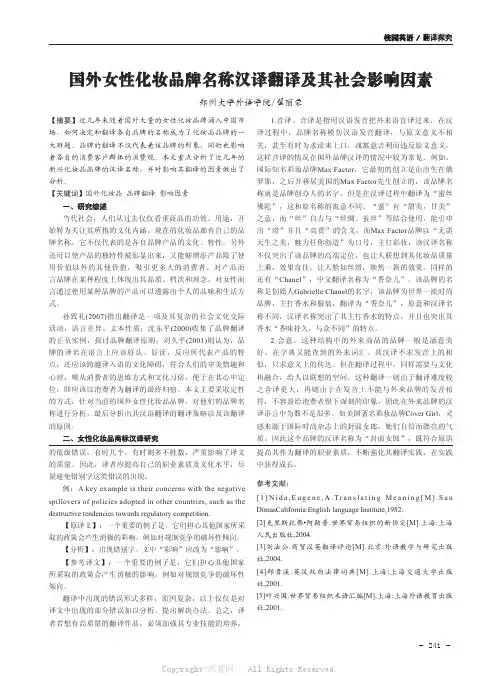
校园英语 / 翻译探究国外女性化妆品牌名称汉译翻译及其社会影响因素郑州大学外语学院/翟丽豪【摘要】近几年来随着国外大量的女性化妆品牌涌入中国市场,如何决定和翻译各自品牌的名称成为了化妆品品牌的一大难题。
品牌的翻译不仅代表着该品牌的形象,同时也影响着各自的消费客户群体的消费观。
本文重点分析了近几年的新兴化妆品品牌的汉译名称,并对影响其翻译的因素做出了分析。
【关键词】国外化妆品 品牌翻译 影响因素一、研究综述当代社会,人们从过去仅仅看重商品的功效、用途,开始转为关注其所指的文化内涵。
现在的化妆品都有自己的品牌名称,它不仅代表的是各自品牌产品的文化、特性,另外还可以使产品的独特性被彰显出来,又能够增添产品除了使用价值以外的其他价值,吸引更多大的消费者。
对产品而言品牌在某种程度上体现出其品质、档次和理念,对女性而言通过使用某种品牌的产品可以透露出个人的品味和生活方式。
孙致礼(2007)指出翻译是一项及其复杂的社会文化交际活动,语言差异、文本性质;沈东平(2000)收集了品牌翻译的正负实例,探讨品牌翻译原则;刘久平(2001)则认为,品牌的译名在语言上应该好认、好读,反应所代表产品的特点,还应该跨越译入语的文化障碍,符合人们的审美情趣和心理,顺从消费者的思维方式和文化习俗,便于在其心中定位,即应该以消费者为翻译的最终归宿。
本文主要采取定性的方式,针对当前的国外女性化妆品品牌,对他们的品牌名称进行分析,最后分析出其汉语翻译的翻译策略以及该翻译的原因。
二、女性化妆品商标汉译研究1.音译。
音译是指用汉语发音把外来语直译过来,在汉译过程中,品牌名称模仿汉语发音翻译,与原文意义不相关,甚至有时为求读来上口,或寓意吉利而违反原文意义。
这样音译的情况在国外品牌汉译的情况中较为常见。
例如,国际知名彩妆品牌Max Factor,它最初的创立是由出生在俄罗斯,之后并移居美国的Max Factor先生创立的,该品牌名称就是品牌创办人的名字,但是在汉译过程中翻译为“蜜丝佛陀”,这和原名称的寓意不同。
商标翻译和跨文化因素探析[摘要]商标是商品的代表符号。
在国际商业竞争中起着举足轻重的作用。
应该注意英汉商标的翻译方法和翻译中的文化因素问题,以期使品牌在目标市场中能够获得文化认同。
标签:商标;翻译方法;文化因素随着我国改革开放的逐步深入,社会主义市场经济的飞速发展,及我国加入WTO后国际贸易的日益增多,越来越多的国内企业把目标市场放在了国外,同时也有大量的国际品牌纷纷进入中国市场。
在参与国际市场竞争时,大家都面临着同一个问题,就是将自己的产品更好的介绍给目标市场的消费者。
首要的工作之一就是,如何得体确切的译好商标(trademark)。
商标译名在国际贸易中的重要性正如美国学者艾·里斯所言:“一个译名的好坏,在销售业绩上有千百万美元的差异”。
商标是商品质量的保证,并且代表了企业的信誉,一个驰名商标就是企业的无形资产和巨大财富。
本文将探讨商标的翻译方法和翻译中应注意的文化因素问题。
一、翻译商标名称的方法1.音译法音译是指在目标语中保留其原语言的发音,也就是用目标语的文字书写原语的发音。
一般来说,如果商标的名称是姓氏、公司名称、或新造词语,在译入语中又无对应含义的词语时,可以采用音译法。
音译应兼顾发音的优美响亮及意义的完好性,这有利于消费者联想起原商标名。
例如:Audi Automobile(奥迪汽车),Motorola Mobile Phone(摩托罗拉),Nobia(诺基亚手机),Simens(西门子电器),Hilton(希尔顿香烟),Whisky(威士忌酒)McDonald(麦当劳),Haier(海尔),Canon(佳能),Philips(菲力普电器),Konica(柯尼卡),Nikon(尼康照相器材),Olympus(奥林巴斯照相器材),Sony(索尼电器),Omega(奥米加手表),Dove(德芙巧克力),Parker(派克钢笔),Rolex(劳力士手表)等等。
这种翻译方法不仅能够保持原有名称在发音和韵律上的韵昧,而且是自身的异国情调和卓越品质具体化了。
翻译品牌时需要考虑的民族文化因素商标的首要功能是对该企业产品与其他企业产品进行区分;商标有利于保证产品质量与企业信誉;商标是商品呈现在消费者面前的第一张脸,可以为消费者提供众多信息。
从上述商标功能中,可以提炼出对品牌命名的相关要求。
1、从内涵上看,商标应能体现产品的属性,能在某一方面对产品作出说明,使之成为商品的第一广告。
比如“青岛牌”说明商品产地;“Coca-cola”反映产品原料;“少女之春”表明产品的使用者;“张小泉”则说明产品创始人。
2、商标选择的词语应是寓意美好的,给人以积极联想。
如Coca-cola ,其最初进入中国市场时以“口渴口蜡”与“蝌蚪嚼蜡”为品牌译名,给人的联想是干涩无味,难以下咽,甚至使人们对其产品产生反感。
而“可口可乐”不仅在发音上与原语高度统一,在意义上也是内涵丰富,赏心悦目,给消费者许多美好的联想,可说其味无穷,不愧是品牌翻译中的上乘之作。
3、商标品牌命名应新颖独特,以区分同类商品。
4、商标词要求有朗朗上口的发音,字词选择应易记易用,避免生僻字的使用,力求简洁明了。
[b]一、中外品牌命名的不同特色[/b]由于文化差异、语言文字使用习惯差异的存在,中外品牌的命名也存在着各自的特质。
品牌是一种商业文化,是民族文化的重要组成部分。
品牌命名受民族文化的影响,体现民族文化的取向。
(一)国外品牌命名特点1 、常以与产品相关的人物之姓名为品牌命名这一特点与西方的文化传统有着密切的关系。
西方文化是个体取向,强调个人意识,常常宣扬个人的努力与贡献,倡导对自我的尊重。
比如汉语中作为贬义词使用的“个人主义”(individualism) 一词在西方则是“认为个人权利和自由是社会中最重要的权利和思想”,可见该词在英语中毫无贬义色彩。
“个人主义”反映在经济领域中,表现之一就是喜用人名或姓氏作为品牌名称,以示对产品发明人、企业创始人或对该产品、该企业作出巨大贡献的人的尊重与纪念,体现个人价值。
影响商标翻译的原则与方法摘要:随着中国国力的日益增强,特别是中国入世以后,中国与外国的贸易往来越来越频繁,中外的各种文化交流逐渐增强。
中国的产品需要走出国门来迎接各种挑战。
而商标作为商品在市场战略中的重要组成部分是迎接国内外市场挑战的非常重要的一个因素,商标翻译的好与否对商品的销售起到关键的作用。
商标翻译是一种跨文化交流的特殊应用文体。
影响商标翻译的因素主要有不同的语言、文化以及民族审美情趣等。
本文将从商标翻译的方法及原则来阐述商标的翻译。
关键词:商标翻译影响因数原则方法商标在现代汉语辞典中是如此定义的:“一种商品表面或包装上的标志、记号(图画、图案形文字等)使这种商品和同类的其他商品有所区别。
”根据定义,商标的主要功能是建立一种识别。
商标是合法注册的品牌,它通常用来保护创建这一品牌者的利益及其生产专利。
商标的翻译对于商品的销售起着举足轻重的作用。
其翻译的目的是为了更好的宣传其产品。
而如何进行翻译,才能达到这一良好的效果使生产的产品在营销过程中树立优质的品牌形象?商标翻译要遵循什么样的方法和原则呢?Ⅰ首先阐述影响商标翻译的主要因素㈠、语言之间差异影响不同种类的语言具有各自不同的但是特有的特征。
在商标翻译中特别需要考虑的是翻译对象的两种语言之间的差异,以及需要去应用这种语言来表示出这种商标它所包含的各类信息。
来达到一种吸引消费者使其产生对这一品牌的好感。
这样翻译的目的就实现了。
如Goldion(金利来)它这里面包含一个词Gold(黄金),这样是抓住了大多数人们都喜爱钱这一事物的特点。
将其放在商标里,可以更好地吸引消费者的眼球。
达到宣传品牌,促进消费的目的。
在英汉商标词中的差异主要表现为英语商标词倾向于使用人名等。
如:Ford(福特汽车)是源自于福特公司创始人Henry Ford的名字;PHNE(达芙妮)是源自一位女神的名字。
而汉语商标通常选用动植物名称或地名。
如:凤凰牌自行车(phaenix);哈尔滨啤酒(harbin beer).㈡、文化差异的影响每个国家都拥有自己特有的文化。
Cultural Differences in Chinese-English Brand Name’s Translation一、课题(论文)提纲二、内容摘要三、参考文献Cultural Differences in Chinese-English Brand Name’sTranslationAbstract:English and Chinese are two of the major languages in the world, reflecting two main cultures. It is well-known that language is a part of culture and is the carrier of culture as well. Language and culture cannot be separated from each other. Language would be meaningless without culture and the development of culture would be restricted by language. At the same time, translation is not only the bridge between different languages, but also the inter-cultural communication between different cultures. However, translators often encounter some barriers which are caused by cultural differences in the process of cross-cultural translating. This thesis attempts to explore the cultural differences and the cultural impact on brand name’s translation between Chinese and the Western countries through analyzing the characteristics of brand name’s translation. At the same time, the author gives more attention tothe main factors of cultural differences: cultural vacancy and cultural clash. Furthermore, the author analyzes the great influence of cultural factors in the process of brand name’s translation. When translating, translators should adopt some proper and useful strategies to avoid the barriers caused by different cultural backgrounds.Keywords:language; cultural differences; cultural vacancy; cultural clash; brand name’s translationIntroductionAs the increase of international communication, the exported products have become one of the important windows to show the national culture to the ot her countries in recent. However, brand name’s translation involves language and culture, it as a very important cultural communication way, the brand name’s translation is closely related to cultural factors. However, during the process of translation, translators always encounter some difficulties caused by cultural differences. For instance, the translators can not find the equivalents in the target culture, or the translators often encounter some barriers that the connotative meanings of quite a lot of words in source language are in conflict with the connotative meanings of their equivalent words in target language.Then, the aim of this thesis is to probe the differences between the two cultures according to quite a lot of examples of brand name’s trans lation.Cultural vacancy and cultural clash often lead to a lot of difficulties in theprocess of brand name’s translation. And if translators can not deal with the difficulties caused by cultural differences, the consumers in the target market often misunderstand the connotative meanings of the brand names. On the contrary, effective brand name’s translation can help people from the entire world to intercommunicate freely. At the same time, brand name’s translation can make our culture richer and more vivi d, so good brand name’s translation plays an important role in introducing cultural information between two different cultures. In order to find whether the brand names at present market are translated properly or not, this thesis makes a systematic research on cultural differences in brand name’s translation. The study can improve the future intercultural translation into a higher level.Generally speaking, Chinese culture is greatly different from English culture. Due to striking differences between Chinese culture and English culture, barriers often occur in brand name’s translation. This thesis is to study cultural differences in brand name’s translation between China and the Western countries in order to make people realize the important role of culture and help translators to obtain successful brand name’s translation.The developments of the thesis are as follows: first is an introduction to the thesis. After introduction, the first chapter analyzes the close relationship among culture, language and br and name’s translation. Language is shaped by culture, and language carriers culture, spreads culture and helps to develop culture. And culture is learned by language. Language and culture are dependenton each other. The second chapter analyzes the cultural differences between Chinese culture and the Western culture which include cultural vacancy and cultural clash. The third chapter explores the impact of cultural differences on brand name’s translation, which includes different value systems, different customs and habits, and different customer psychology. The fourth chapter is a problem-solving section, which explores the practices of brand name’s translation. Last is conclusion. From the analysis of previous chapters, it emphasizes again that brand name’s translation is a kind of cross-cultural communication. Owing to the close relation between culture and translation, it is impossible to study brand name’s translation without culture.Ⅰ. the Relationship among Language, Culture and Brand Name’s Translation1.1 Literature ReviewAs international trade expanded, the effects of culture are becoming more and more important. Chinese culture and English culture belong to two different systems. This thesis gives more attention to cultural vacancy. The definition of “vacancy” was first proposed by American linguist Charks Hockett in 1950s.He used “random holes in patterns” to describe the language phenomenon when contrasting grammatical patterns of two languages.In China, there exist two main definitions a bout “cultural vacancy”: Wang Bingqin (1995:110) remarks that “vacancy” refers to the cultural vacancy resulting from unintelligible things in SL that will be easily misunderstood at allby target culture receptors. Pan Huixiaand Li Hui(2000:74-77)give this definition that “vacancy” refers to the unique phenomenon of language and culture which is specific to a nation while does not exist in another culture.Although these definitions are expressed in different words, they reflect one fact that cultural vacancy refers to the linguistic and cultural facts which exist in one national culture but default in another due to cultural differences.The author divides the cultural vacancy into two aspects: lexical gap and semantic gap. Since lexical gap is closely related to language and culture, it is basically manifested at the word level and more specifically, to the denotation and connotation of a word between two languages. When mentioning lexical gaps, Professor Lin Dajin uses the term of “Psychological-associate d meaning” in Intercultural Communication Studies(1996:185-188)to distinguish the following five types: total absence of psychological association, the same denotation but different connotations, the same denotation but absent connotations, the same connotation but different denotations, different denotations and different connotations. Semantic gaps resulted from the non-equivalents are manifested in the denotation and the connotation of the words. Some words have less or more connotations in English than in Chinese, or, some words in both languages appear to refer to the same thing on the surface, but actually refer to quite different things. Since the “cultural turn” in the 1990’s, translation concerns not only the transferring between languages, but also the transferring between cultures. The main difficulties in translation comefrom the fact that some words in source language can’t always have their equivalent words in target language. So, during the process of translating, the problem how to deal with the cultural differences is a meaningful task for our study.In terms of translation principles, Bao Huinanstudies C-E brand name’s translation from the perspectives of language and culture. He advances this principle: translators must respect the national psychology and grasp the associative meaning. The chosen words should be simple, brief, and catchy (Bao Huinan, 2001:274-287). Bao Huinan (2001:274-287) agrees that culture plays an important role in brand name’s translation, stresses the importance of an appropriate conversation of cultural meaning and clearly puts forward the opinion that ignoring cultural differences may cause pragmatic failures in brand name’s translation.According to the studies of other scholars, the author attempts to discuss cultural differences in C-E brand name’s translation.1.2 Language and CultureLanguage is a social phenomenon which satisfies human beings’ needs to express culture and create culture. The basic distinction between human beings and animals is that human beings have the ability to make use of language. Language is the central part of people’s social activity. Without language, the literature, sciences and economical systems can not exist. Bloch andTrager (1942:5) have a definition of language that a language is a system of arbitraryvocal symbols used for human beings. And Samovar(2000:120)noted that “A language is a part of a culture and a culture is a part of a language; the two are intricately interwoven so that one cannot separate two without losing the signi ficance of either language or culture.”Culture is a very complex concept. It is the product of the people through their creation work and it plays a significant role in people’s life. It is a system in which people share beliefs, values, customs and behaviors. Many definitions about culture have been given from different fields. The most important definition of culture was given by Edward Tylor,a British scholar in 1871. This definition was widely accepted over a hundred years ago. In the book Primitive Cu lture, he defined culture as “a complex whole which includes knowledge, beliefs, art, morals, law, custom, and any other capabilities and habits acquired by individuals as members of a society(Tylor,1871:36).The fact is that language and culture are closely related to each other and the two factors cannot be separated at any time. And it is generally agreed that it is because of the existing of language, culture can be transmitted from generation to generation through leaning. Therefore, if people want to learn a language, they must know well about the culture, and if people want to know the culture, they must study the language. On the other hand, any change in a culture often embodies corresponding change in its language, and gives rise to new brand names. For instance, when Chinese people are influenced by the Western culture and accept it, some new words in Chinese language appear.Many Chinese words are from the Western religious culture, economical culture and so on. For example, the brand name“奔驰”is t ranslated from the brand name“Benz”.At the same time, it is easy for people to notice this phenomenon that as more and more new brand names appear in Chinese market, language has developed. So, if people are eager to understand a language, they must know well about the culture and the customs of the culture in which the language is spoken. It is very quite reasonable to say that learning a language is to learn the culture and leaning a culture is to lean the language. Therefore, it is very accurate for Nida(2002:146) to conclude that “language and culture often combine in a kind of symbiosis.” Chinese culture and English culture are different. Owing to the differences in the social environment, history, religion and region, cultural differences will be embod ied in language. Take “regional cultural differences” as an example. China is a country based on agriculture, and the majority of the people make a living by farming. So, there are many words and expressions which are related to“牛”, such as, the brand name“红牛”.However, most Westerners do not like to use the word “bull”as the brand name. It is the reason that“牛”has different cultural meanings in the minds of the Westerners because of the different regional cultures. Cultures differ from one another, and each culture is unique. As cultures are diverse, so are languages.1.3 Culture and Brand Name’s TranslationIt is common to assume that cultures differ from each other and eachculture is unique. Nevertheless, in the age of globalization, cultural boundaries are blurred. Translation leads to exchange of cultures between the Chinese culture and the Western culture. From the relationship between language and culture, it is obvious that translation is not only the process of transferring the source language into the target language, but also the process of a mutual communication and exchange of the two different cultures. The main purpose and characteristic of translation are to exchange ideas and cultures. Translation can also be called a “cultural translation”, b ecause culture factor is taken into consideration.The differences between the source culture and the target culture are the main headaches for translators or theorists to bridge the cultural gap. The translation case of“White Elephant”(translated from the Chinese brand name“白象”) is a typical example to indicate the mistranslation between different cultures. Then, translators should be sensitive to cultural differences.Culture is of great importance in brand naming, for the main usage of a brand name is t o attract consumers to purchase, or satisfy the consumers’ needs.A successful brand name will bring benefits to the producers. Today, translators not only face the consumers from the same cultural background, but also consider the needs of consumers from different cultural backgrounds. It is impossible for all consumers from different cultural backgrounds to accept the cultural information which is loaded in brand names. On the other hand, culture is transmitted through brands. Brands, as an important carrier of culturalinformation, indirectly or directly show or influence the cultural meanings of their own nation. Brand name’s translation is regarded as a kind of cross-communication between different cultures.2. Two Aspects of Cultural Differences in Brand Name’s TranslationOwing to the close relationship between culture and language, brand name’s translation is closely related to culture. However, the striking different cultures often bring a lot of difficul ties in the process of brand name’s translation. So, cultural differences are the inevitable problems that translators must consider. To a large extent, cultural differences in brand name’s translation mainly include cultural vacancy and cultural clash.2.1 Cultural VacancyOwing to cultural differences in historical backgrounds, religious beliefs, social culture, value systems, customs and habits, many expressions in source language have no their own equivalents in target language. This phenomenon has brought great barriers in the process of brand name translating. One of them is about “cultural vacancy” which is the main barrier in our cross-cultural translating. Cultural peculiarity is the main factor leading to cultural vacancy, which is the basic exampl e of cultural differences. The definition of “vacancy” was first proposed by American linguist Charks Hockett in 1950s.He used “random holes in patterns” to describe the language phenomenon when contrasting grammatical patterns of two languages.In China, there exist two main definitions about “cultural vacancy” byWang Bingqin(1995:110), “vacancy” refers to the cultural vacancy resulting from unintelligible things in SL that will be easily misunderstood at all by target culture receptors. Pan Huixia and Li hui point out that “The unique phenomenon of language and culture which is specific to a nation while does not exist in another culture”(潘惠霞,李辉,2000:74-77).It is easy for people having the same cultural background to understand the omitted part, but it is very difficult for people from different cultural backgrounds to understand the cultural connotations entailed in brand names. For example,“红豆”in Chinese culture is a symbol for love and missing. But “red bean” in English culture is just for a bowl of red bean stew in a story. Another example is about vocabulary vacancy between the Chinese language and the Western language in brand name’s translation. The following brand names have no equivalents in the Western language, such as“王老吉”(drink)and“稻花香”(alcohol). In this thesis, the author mainly studies cultural vacancy from the following aspects: lexical gap and semantic gap.2.1.1 Lexical GapOwing to the close relationship between culture and language, cultural differences naturally lead to the differences in the aspect of lexicon. China has a long history about 5000 years. And some words which are related to the Chinese long history have rich cultural information. However, most words have no equivalents in the Western language. Therefore, these words cannot be literally translated into the English language. But, as people have strong feelings aboutthese words, these brand names can arouse a good impression on Chinese consumers, such as, “同仁堂”,“王麻子”(scissors),“王老吉”(tea),and so on. Lexical gap may be a major barrier in intercultural communication, and this thesis divides lexical gaps into two main aspects: non-equivalent concept and non-equivalent expression.Non-equivalent concept refers to the fact that a concept which exists in source language is absent in target language. This expression conveys the idea that a term in English or Chinese does not have an equivalent in the other language. In traditional Chinese culture, many words which denote special cultural information have no equivalents in Western cultur e. For example,“淑女屋”(clothing)---(from Shi Jing《诗·周南·关》---窈窕淑女,君子好求),“嫦娥”(moon cake)---(from a mythology--嫦娥奔月),“长城”(electric appliance)---(a symbol of China)are all bestowed with positive culture images. Besides,“粽子”is a very famous traditional food in Ch ina, but there does not exist equivalent of the word“粽子”in the Western language. On the other hand, some English words reflecting the Western culture may be difficult for Chinese people to understand their meanings, as no equivalent lexical words are avail able in the Chinese language. For example, “Jetta” is the brand name for car. Its Chinese name is“捷达”,which means convenient and swift reaching.“Mcdonald”is translated into“麦当劳”,which is a kind of fast food. Apart from these, there exist many examples about non-equivalent concept between English-Chinese brand name’s translation, such as Golf(高尔夫),Hamburger(汉堡包),“Giordano”(左丹奴),“Coca-cola(可口可乐),and“Pizza”(比萨).Non-equivalent expression indicates the fact that the expression of an existing concept is absent. Some word is easy to grasp the meaning of the expression, but it is difficult to translate it into Chinese. This phenomenon occurs in Chinese-English brand name’s translation. For example, in Chinese traditional culture, the term“状元”symbolizes a person who is the best in a national test. Before the emergence of the expression“状元”,we believe that there also exist some words in the Western language which have the same meaning as the word“状元”,such as the words“Champion”and“Number One Scholar”,whereas in the We stern language, there has no word to name these. New expression always enters with a new name, but it really takes time for the natives to get familiar with the new term.2.1.2 Semantic GapIn the 1970s, British linguist Geoffrey Leech published his book Semantics which put the study of meaning in an entire social and cultural framework. He recognized the importance of cultural circumstances in language use and brought semantics into closest contact with people’s cultural life. Due to the close relationship between culture and language, cultural vacancy is the root of semantic gaps. Some words in the source language have no cultural equivalents in the target language. This phenomenon is called semantic gap. In this thesis, semantic gaps between Chinese and English are divided into twogroups: the same denotation, but the different connotations and the same denotation, but the absent connotations.Since human beings contact with animals and plants frequently, we can notice that a lot of names of animals and plants are used in Chinese and English brand names. However, because of different cultures, the connotations of animal words in one language do not necessarily coincide with those in another. The cultural images of animals have many differences in different countries, which affect translation. According to the Bible, “sheep” refers to the kindhearted person. On the contrary,“goat” is compared to the malicious person. Even lamb has its special religious connotation, which is the image of Jesus who suffered a l ot for people. While in the Chinese language, these animal words don’t have such religious meanings. And“羊”(yang)is similar to“祥”(xiang)in pronunciation, so“祥”in the Chinese language indicates good luck. In addition,“玫瑰”and“rose”symbolize“love”in both Chin ese culture and the Western culture, the connotative meanings are different in other aspect. In English culture, the word “rose” used in a certain expression indicates the connotation of“silence” or “secret” ,such as, “under the rose”.So, we can conclude that the non-equivalent in meanings shows this fact that the cultural gap between the Chinese language and the English language exists. During the process of inter-communication of brand names between two cultures, it is inevitable to avoid the cultural gap.2.2 Cultural Clash in Brand Name’s TranslationOwing to the different historical and social development China and English-speaking countries, culture is always nation-specific. So, cultural clashes are inevitable problems which translators have to face. Since language is the carrier of culture, the clashes between Chinese culture and the Western culture are reflected by the clashes between the two different languages:the conflicting denotations, or the conflicting connotations and the same denotation, but conflicting connotations.Because of the differences between the Chinese culture and English culture, people have different value systems and different beliefs. For the same word, people in different cultures may have different associative meanings. Conflict of word meaning is often caused by the abundant cultural connotations of words. For example, in Chinese culture,“白象”is a brand name of batteries. The word“白象”will gives people the feelings of“clean”and“lovely animal”.When“白象”is used to be the brand na me, it was soon accepted by most people. However, in the English culture, “white elephant” symbolizes something useless. If it is translated into“白象”literally, it is certain that the consumers in the English-speaking countries will not be fond of it.As the Chinese culture and English culture belong to two different systems, the associative information of brand names is sometimes contrary to each other. Take the word “dragon” as a typical example. In the minds of Chinese people, “dragon” indicates good luck and fortune in future and symbolizes power. “龙”is even a symbol of China and Chinese people are calledthe “descendants of the Dragon”. It is easy for us to find many expressions related to the word“龙”,such as“真龙天子”,“望子成龙”,“龙腾虎跃”and“生龙活虎”.While in English-speaking countries,“dragon”is regarded as a threatening animal. In the Bible, Satan Devil is compared to “the great dragon”, while those who have killed dragons are called heroes. And the idiom “to show dragon’s teeth” means “to sow the seed of misfortunes”.3.Cultural Impact on Brand Name’s Translation3.1 Different Value SystemsValues are a learned organization of rules for making choices and for resolving conflicts. “These rules teach us what is useful, good, right, wrong, what to strive for, how to li ve our life, and even what to die for” (Samovar, Porter & Stefani,2000:60).In other words, the value system includes people’s opinions about the world, people’s beliefs and so on. In one word, the value system is playing a basic role in deciding people’s b ehaviors and thoughts. Thus, the value system of culture is a very important factor affecting brand name’s translation, for different nations have different behavioral standards.Since individualism is regarded as an important factor of value systems in Western culture, individualism plays a basic role in the establishment of relationship among human beings. Even the Bible carries examples of individualism.The author takes some brand names as examples to prove this phenomenon. Producers support many products or services for consumers topurchase freely, such as“classic Coke”, “King Coke”, and “Diet Coke” .Apart from these, individuals hope to get great achievements, and then they will be thought as the important valuable persons. To meet this value of consumers, there exist many brand names, such as “Pilot”,“Commander” ,and “Hp”.However, individualism is not the driving force in all cultures. The Chinese equivalent of“individualism”is“个人主义”,which is,on the contrary, a negative concept. According to《现代汉语字典》(The Contemporary Chinese Dictionary),“个人主义”has the following explanation:“一切从个人出发,把个人利益放在集体利益之上,只顾自己,不顾别人的错误思想.”(吕叔湘、丁声树,1983:373).Chinese culture put emphasis on social relationships as opposed to Western culture emphasizing on individuals. Obviously, Chinese culture is greatly affected by the thoughts of Confucianism which guide Chinese people to do something properly.3.2 Different Consumer PsychologiesDifferent cultures shape different psychology reaction to the same object. So, same brand names bring about different results in English and Chinese consumer psychology. Consumers’ different cultural environments can in a great degree decide his psychological response to the connotative meanings of a brand name. For instance,“水仙花”(narcissus)in China is esteemed as the flower with such noble characteristics as being neat and graceful that many manufactures would like to adopt it in their brand names. In contrast, the Western consumers are likely to associate it with the images of beautiful youthor self love or excessive self-admiration because the word “narcissus” originates from Narcissus, who was a beautiful youth in Greek mythology. It was said that the beautiful youth fell in love with his reflection in water, died and was turned into a flower with his name. So it is the representative of excessive self-admiration. Now, we can imagine who will buy a product that is quite self-admired.A Chinese enterprise produces a type of toothpaste named“黑妹”,delivering the message that even a girl with black teet h can turn her teeth white if she uses the toothpaste. We can image what response the product would meet if it is translated as“Black Sister” ?It is not only the symbol of disaster but also an offense to the Blacks.Thus, it is highly important to know the psychology structure of the target customers and their psychological response in order to avoid target customers’ misunderstanding of the different psychological structure of the source culture.3.3Different Customs and HabitsIt is well-known that custom is the way of life in a community, and custom includes many aspects, which concerns all kinds of field of social life. Different nations have different customs and habits. People are inclined to purse good luck, which can be reflected in brand names. In China, people often use the numbers“六”,“九”,and“双”to express good luck. Besides, Chinese expression“红喜”refers to getting married, celebrating birthday, giving birthhappily. And the word “红”are frequently used to be brand names to arouse the feelings of happ iness and success on consumers. The brand names“红旗”(car),“红双喜”(shoes),“红塔山”(cigarette),“红蜻蜓”(shoes)are commonly seen in Chinese market. Death is considered as white happiness, as white is frequently the color of mourning in China. Although weddings and funerals can be translated into Chinese“红白喜事”,cultural connotations are lost. If English speakers do not know much about Chinese culture, they can still understand the meaning of“红喜”with the aid of red-letter days, and they will be most surprised at the funer al referred to as“白喜”,which is peculiar to Chinese culture.Different customs and habits may also result in different cultural connotations. Chinese people have special feelings about some animals, especially“龙”.“龙”is the symbol of noble spirit of the nati on and the system of the ancestor or the king of the nation. At the same time, Chinese people take the dragon as the symbol of the Chinese five-thousand-year civilization. In their minds, the dragon will bring good luck to them. That is why Chinese consumers like to purchase the products named after“龙”,such as “金龙鱼”“龙牌”,“飞龙”,“红金龙”.While in English culture,“dragon”does not have this good reputation as it does in China. When the Westerners see the name, they will associate a fierce monster with it. So “dragon” is seldom used as brand name in the English-speaking countries.From the above analyses we can see that correct treatment of the。
商标名称与翻译1.引言这是一个商品经济的时代,随着世界经济的蓬勃发展,品牌已渐趋全球化,消费者的品牌意识也愈发强烈。
“品牌”,也就是商标,是区别不同生产者的标记。
这种标记通常由文字或图形单独构成或组合而成。
而商标词又是商标的重要组成部分,它具有特定的标志意义和丰富的象征意义,承载着独特的商品信息和文化信息,对于提高商品知名度和开拓市场功不可没。
因此,商标在广告营销策略中已显得尤为重要。
而其翻译,即在不同语言间进行恰当的转换也绝非易事。
本文将从现有商标翻译存在的问题出发,分析成因并根据商标翻译的方法和技巧总结商标翻译基本原则。
2.商标的涵义及作用2.1商标的涵义商标是指刻在或印在一种商品的表面或包装上的标志、记号(图画、图案形文字等),使这种商品和其他的同类商品有所区别。
那么商标究竟应该译为brand还是trademark呢?首先,brand是商业术语。
市场营销学最高学术权威机构美国市场营销学会对brand和trademark分别定义为:Brand is a name,term,sign,symbol,design or some combinationused to identify the products of one firm and to differentiate th-em from competitive offerings. A trademark is a brand that hasbeen given legal protection and has been granted solely to itsowner.(王才英,2006:130)定义指出brand是个名词、术语、符号、图案、设计或这些因素的组合,其作用是区别卖者的产品。
而trademark是受法律保护的brand。
它使它的所有者对其具有专有权。
后者是在前者的基础上发展而来的。
2.2商标名称具有以下作用:2.2.1表示商品出处,便于确定生产销售者责任;标有同一商标的商品,就表示它们是由同一企业生产或销售的,这使得其生产或销售者必须承担应尽的责任。
商标名称翻译中的文化因素及影
响
李
黎
摘要丈化因素在翻译特别是商标名称的翻译中具有非常重要的作用在对商标名称的翻译过租中应当考
虑
文化因素的
影响根据中西文化的差异做出恰当的调整和转换从而保证商标译名具有良好
的广
告效果
关健词文化因素翻译商标名称翻译
广
告
效果
加入世界宽易组织后中国与世界的联系更加
紧密
中国
的产
品走向世界外国的产品进入中
国市场都面临着商标名称的翻
译
问
题一个在本国具有很高知名度和美誉度商品品牌在其他国
家
的市场上是否也能够得到消费者接受和欢迎除了经
营策略等因
素
以
外对其商标名称的恰当的翻译也是至关重票的
由
于
地域环境
不同中西方在风俗习惯在民族性格传统文化等方面都
有很大
不同从而也形成了各具特色的审美心理
因此在商标名称的英
汉互译中要求译者要充分考虑文化因素的影响要熟悉并林重中西
文化的差异在翻译过程中做出适当的文化转换和变通以保持译
名
原有的良好效
果
商标名称按其构成可分为缩略词汇商标名称普通词汇商
标
名
称和特珠词汇商标名
译
者可根据
商标名称不同种类的特
点
进行
相
应的翻
译
手
以保证其译名
摘略询汇商标名称指由企业名称产品
名
称
感
制造工艺辱词语的首锹母缩略的商标
词
效
果
产
品构成
比
如
扭指
从
亡
即
场
功如七和盆妙币山日训自
姻
如
这
类缩略词汇
商标名
文化因寮对翻译的影响
升问翻译都离不开文化所谓翻译无非是通过一种语
言转
达另一种语言的文化信息谭载喜说翻译中减原
文
惫思的理
解远远不是单纯的语言理解问题译者对某段文
字
理解的正确
与
否在很大程度上取决于他对有关文化的了解对于译者来说没
有两种文化的对比知识就无从谈起对语言文字的正确理解与表
述
在英语中有一句成语‘叨咖咖文字表
面
意思是在不觉寒中招待了天使可能会令中国人有些不知所云但
是了解一下西方文化就会知道琪实就相当于中国文化中的神
仙那么这句话的意思是在不觉察中招待了非常重要的人物
但是这样表述显然是平淡无味假如译者再有一些中国文化
底组
的
话就会知道有眼不识泰山是非常贴切而又地道的汉语译
文
同样只有深谙中
西两种文化差异并具有深厚的文化素养才能将汉
语中穷得象乞丐翻译成幽直的英文
文
化因班对商坛名稼英汉互译
影
响
称一般在某‘行亚具有广泛影响又在我国文化可接
受范围之内
可以直接拿律角其读音就是各个组胶宇母的发香不
需
蘸
翻
译
专有名何商标名称指借用人名企业名称或其他专
有
名
词构成的商标名称如以
刀妞吉列知
,
,
场克莱斯
勒
处扣
。
杜邦这类商标名称的翻译主要采用音译其汉字
的
选用
要适应汉字因形见义的特点尽利千有益联想
脆透词汇商标
是商标设计人根据一定意圈借助某种构词
法或完全凭空杜撰出来的新诃如故爱乐曲芬达这种商
标名称一般采取音译汉字的选择最好能与商标所标识
的商品联系
起来
普通词汇商标名称这类商标名称用既有的英语
或
汉
语普
通词汇构成多是取其词汇的
比
喻意义或象征愈义来实现
有
益联
广告效果或在
中
的友法在意译不能达到预期的
意译不能突出原名良好效
果
的
情况下可很姆译入语国家的文化特点进行音译或采用意
译加
音
译
的
方法以保证该商标名称在译入语国家具有同样良好的效
果
直接意译中西文化不存在差异原名
的
语用意义能
为
译入语国家消费者欣然接受时可用愈译的方法如即苹果
牌
服饰。皇寇牌轿车永久牌自行车英文商标名
称
好的商标名称能使消费者产生一种有益于该商
品
销售的相关联
想继而产生
喜爱之油激起购买欲望商家选用商标名称时所着
重考虑的是如何突出商标名称的广告作用由于功能上的特殊要
求商标名的姗译宜遵循翻译理论户的等效原则
咖
奈达说在动态对等翻译中译者所
关
注的并不是源语信息和译语信息的二一对应关系而是尸种动态关
彰
箕
羹鬓羹薰蒸翼翼篡薰郭
原
语
调
两
一
个商标名称要想起到好的广
告作用让大众
接受就应该符
合大众审美心理和文化习惯因而商标名称的翻译要考
虑
译入语
国家的审美心理和文化习惯才能
使该品名为当地民众
所接受使
其产品顺利地打开当地市场不同地域的人省南不同的风俗文化
形成了不同的审美心理因而同一商标名称在不同文化群体中产生
的作用也是不同的
饮料七喜英文原
名,一有在上向上
奋发向上的意思非常符合英语国家人
民求新求异不
断
追求成
功的民族心理但如果把它直译成中文七上
中国读者很自
然
就会想起成语七上八下很难接受这时译者作适当的文
化
转
换和变通用喜来音译就比较符
合中国人命名因形
见义图吉利的特点使中国民众乐于接受又
如勤劳可爱的
蜜蜂一直是中国人赞美的对象蜜蜂牌洗澡香皂很容易
被
接
受但是如果其商标名称在英语国家中被彦译为,,就很难
使消费者产生认同感在他们看来蜜蜂身上有几乎看不到的绒刺擦
在身上感觉不到舒服当然不愿去买这种香皂所以说商标名
称
的
翻译是一种跨文化的翻译它要求
译者以其深厚的文化素
养去体
会把握原文所承载的文化信息并结合不同文化的差异作适
当
转换才能出符合译入语国家文化背景和大众审美心理的译
名
商标名称的英汉
互
译
都是非常地道忠实的译名很容易为译入语国家人民所接
受
音
译或音译加
意译但是在很多悄况下由于中西
文
化的差异中华民族和英语国家民族具有不同的传统习惯和审美
心
理对同一实物形象会产生不同的文化联想这时就要特别注意
中
西方不同的文化特点进行音称或音译加意译音
译时所用宇
眼
要
选择符合译入语国家大众心理特点切合商品特性的字词使其
符
合译入语国家文化特点和大众审美心理以确保商
标名称具有与在
原语国家相等的或更好的广告效果音译加意译时可加上能反
映
商
品特性的字眼如美国运动系列商品止商标名
称
意
指古希腊胜利女神若不采用衰译难以夸越中西文化差异的障
碍
但是如果根握运训暇润左该经久商命的特
点
音译
为耐克就
暗示了既坚固耐穿又克敌必胜正好与商标原名的
意义相符
商品生产者选择商标时着霉寒出的是其捉进商品销咨的广
告
作用因而在对商标名称进行翻译时也重在保持其原名大致对等
的
广告效果在中英文化具有差异形成交流障
碍时要根据两种文
化不同的特点和审美心理在日译时做适当的调整使其能够
同
样
深入译语国家消费心理激发其美好的想象和购买
欲
望促进该产
品在译入
语国家的
钠售
参
考文做
川刘毖庆著当代翻译理论北京中国对外
翻
译
出版公司
年
郊著章主编英汉互译实用教程武昌武汉大学出版社
年
网陈宏筱编著祈实用汉译英教程武汉湖北教
育
出
版
社
年
其余
参考
文
肤略
作者筒介
李黎一女硕士任教于平顶山学
院
收稿日期
作者单位
平
顶山学院